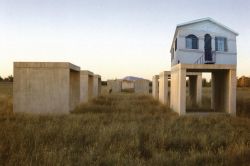 Photo Credit: Alan Rosenblum
Photo Credit: Alan Rosenblum
Courtesy of Estudio Teddy Cruz
Home to the nation’s busiest United States-Mexico border crossing, San Ysidro is a suburb of San Diego, California, that lies just north of Tijuana, Mexico. Comprising mostly third- to first- generation immigrants, San Ysidro is often ignored, viewed as a place to pass through on the way to and from the border. Many San Ysidro-Tijuana families live in a bi-national condition, a state of being that finds families, work, education, affordable housing, health care, and economies tied to one another, and one that is currently struggling with the hot spots of drug cartel violence. Casa Familiar, a San Ysidro-based nonprofit organization, is working to invigorate the community by advocating for and assisting the residents in such areas as immigration services, education, and job placement[i].
While others see poverty in the housing developments in Tijuana’s outer-ring neighborhoods, Teddy Cruz, an architect and professor at the University of California, San Diego, sees them as evidence that creative intelligence, and the participation of informal communities, can shape new forms of urban development. In Tijuana’s hilly terrain, people transform their open spaces into social spaces, residences, and businesses, which are constructed using found materials—corrugated metal, discarded packing crates, and garage doors are cobbled together. Developments are painted in vivid colors; new floors and rooms are added when needed, and residents fit family-owned restaurants or businesses near and under houses that are very close to each other[ii].
Cruz appreciates the result, as it produces a lively and spirited landscape. Under Mexican law, once a new settlement is complete, it is protected from demolition. Cruz asserts that this approach is far more flexible and democratic than many currently accepted as models for urban development.
Shuttling back and forth across the border, Cruz sought to reproduce the vibrancy of Tijuana in San Diego’s suburb, but struggled with initial development plans due to San Diego’s strict building and zoning codes. Cruz was then offered an opportunity to work with Casa Familiar, and together with the organization developed the Mi Pueblo Village Project as a strategy for revitalizing the village. Cruz designed two innovative affordable housing developments for the Village Project, and created a new model for rebuilding San Diego’s older neighborhoods. Casa Familiar is seeking approval as of March 2012 of the two housing projects, which would support greater social interaction in Mi Pueblo.
The two projects, Living Rooms at the Border and Abuelitos Senior Gardens, comprise 23 units of affordable housing, to be built in the oldest San Ysidro neighborhood. The neighborhood lies within a half-mile radius of the Casa Familiar campus, which includes its Social Service Center, Civic Center, Recreation and Fitness Center, and Community Design and Arts and Culture Center. The Living Rooms feature a “semipublic loggia as a micro-enterprise and arts development space as its centerpiece” and is a new development model that encourages innovative thinking about ways to build community infrastructures that connect affordable housing to social, economic, and educational support systems.
Abuelitos is a design for housing grandparents who have custody of their grandchildren, a need that Casa Familiar identified through its Social Services Center. Cruz’s designs inject themselves into the historic core of San Ysidro, and connect a range of housing, from affordable to more expensive to existing informal access ways that serve as public open spaces. His designs incorporate affordable housing and represent a reconsideration of urbanism. They buck the trends of suburban pitched roofs, front porches, and lawns and strengthen the role that community-supported rebuilding can provide in the ring of suburbs around urban cores. Cruz develops these designs as an alternative to the plans for generic, urban developments that maximize density through unit counts, rather than socio-economic interactions.
Teddy Cruz recognizes that the many modifications of tract developments and shanty towns, made by residents of Tijuana, add character, a sense of place, and stimulate community pride in neighborhoods. His designs are devices to re-imagine housing in San Diego. With increasing numbers of middle-class immigrants moving to the suburbs in lieu of city centers, it is important to think about and address the needs of the new suburban demographic. By including informal networks of public space and architectural solutions that allow residents to modify their space to meet their own needs, Cruz’s designs have encouraged planners and architects to rethink design approaches and to accommodate social interaction and mixed-use settings. Cruz’s imaginative design for Casa Familiar’s Mi Pueblo transforms it from a conventional neighborhood revitalization plan to one that weaves community infrastructure, support services, public spaces, and affordable housing into a colorful addition to San Ysidro.
For more infomation, please check out Casa Familiar at: http://www.casafamiliar.org
. The Museum of Modern Art, 2011. Web. 07 Mar. 2012. <http://www.moma.org/interactives/exhibitions/2010/smallscalebigchange/projects/casa_familiar>.
Ouroussoff, Nicolai. "Shantytowns as a New Suburban Ideal." The New York Times, 12 Mar. 2006. Web. 7 Mar. 2012. <http://www.nytimes.com/2006/03/12/arts/design/12ouro.html?_r=2&pagewanted=all>.